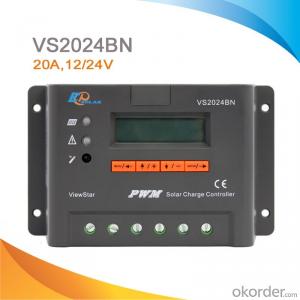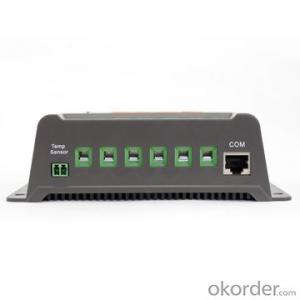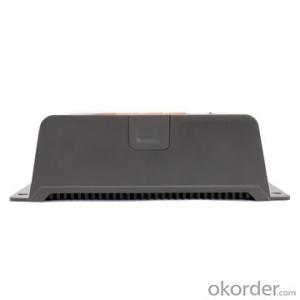LCD/LED High Quality PWM Solar anel charge controller/regulator 10a 12/24v with CE ROHS 20A ,12V/24V,VS2024BN
- Loading Port:
- Tianjin
- Payment Terms:
- TT or LC
- Min Order Qty:
- -
- Supply Capability:
- 10000 pc/month
OKorder Service Pledge
OKorder Financial Service
You Might Also Like
Features:
·Excellent EMC design
·32 bit MCU with high speed
·High efficient Series PWM charging
·Four battery type options: Sealed, Gel, Flooded, and USER
·Intelligent lighting and timer control for solar lighting system
·12 bit A/D high-precision sampling to ensure accuracy
·Use MOSFET as electronic switch
·Full control parameters setting and modification, diversified load control mode
·Humanized design of browser interface, undertake every operating conveniently
·Temperature compensation
·Adopt graphics dot-matrix LCD screen and HMI (human-machine interface) with 4 buttons,integrated menu displaying and operation
·Energy statistics function
·RS485 ports with MODBUS communication protocol
·Optional PC monitoring software and remote meter for real-time monitoring and battery management parameter setting
·Field upgradable firmware
Electronic Protections:
·PV short circuit protection
·PV reverse polarity protection
·Battery overcharge protection
·Battery over discharge protection
·Battery reverse polarity protection
·Load overload protection
·Load short circuit protection
·Overheating protection
Specification:
Model | cn1 | cn2 | cn3 | cn4 | cn5 |
Nominal system voltage | 12V/24V auto work | ||||
Rated battery current | 10A | 20A | 30A | 45A | 60A |
Rated load current | 10A | 20A | 30A | 45A | 60A |
Max. battery voltage | 32V | ||||
Equalize charging voltage | Sealed: 14.6V, Flooded: 14.8V, User-defined: 9~17V | ||||
Boost charging voltage | Gel: 14.2V, Sealed: 14.6V, Flooded: 14.8V, User-defined: 9~17V | ||||
Float charging voltage | Gel /Sealed /Flooded: 13.8V, User-defined: 9~17V | ||||
Low voltage reconnect voltage | Gel /Sealed /Flooded: 12.6V, User-defined: 9~17V | ||||
Low voltage disconnect voltage | Gel /Sealed /Flooded: 11.1V, User-defined: 9~17V | ||||
Self-consumption | ≤15mA(12V); ≤10mA(24V); ≤9mA(36V); ≤8mA(48V) | ||||
Grounding | Common negative | ||||
Temp. compensation | -3mV/°C/2V | ||||
Relative humidity | 10%~90% Non-condensation | ||||
Communication | RS485 / RJ45 interface | ||||
LCD temperature | -20°C ~ +70°C | ||||
Working temperature | -25°C ~ +55°C | ||||
Humidity | ≤95% N.C. | ||||
Enclosure | IP30 | ||||
Overall dimension | 162x85x40mm | 162x100x50mm | 200x103x58mm | 201x109x59mm | 205x129x67mm |
Terminals | 4mm2 | 10mm2 | 16mm2 | 35mm2 | 35mm2 |
Net weight | 0.2kg | 0.4kg | 0.7kg | 0.9kg | 1.3kg |
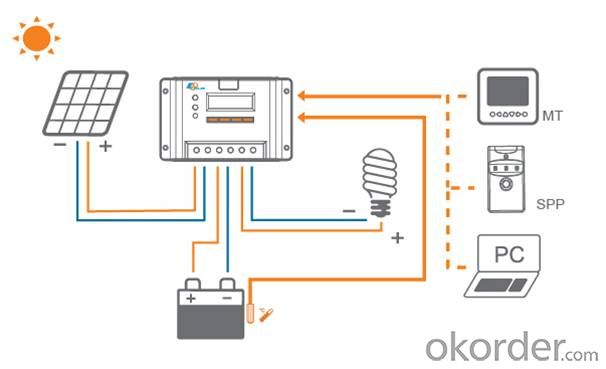

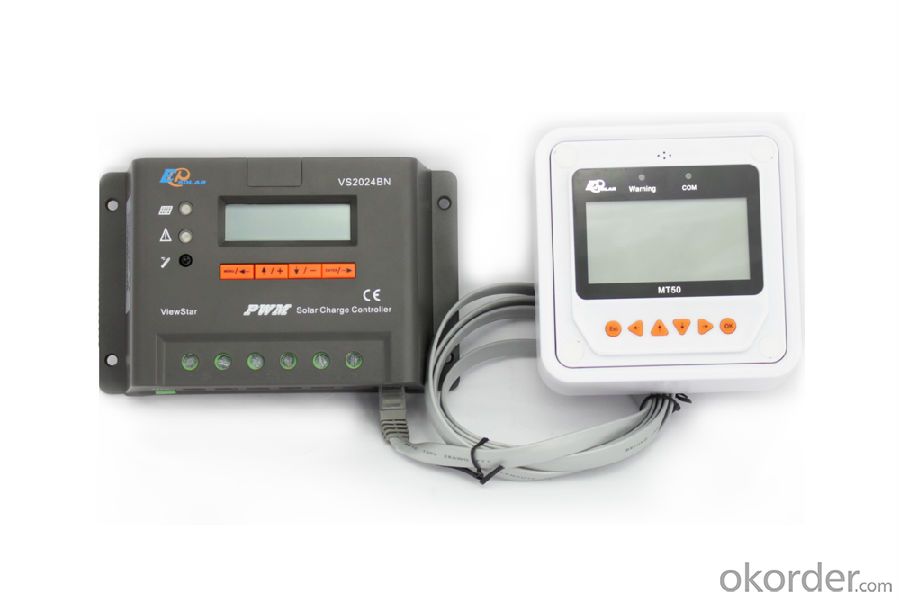
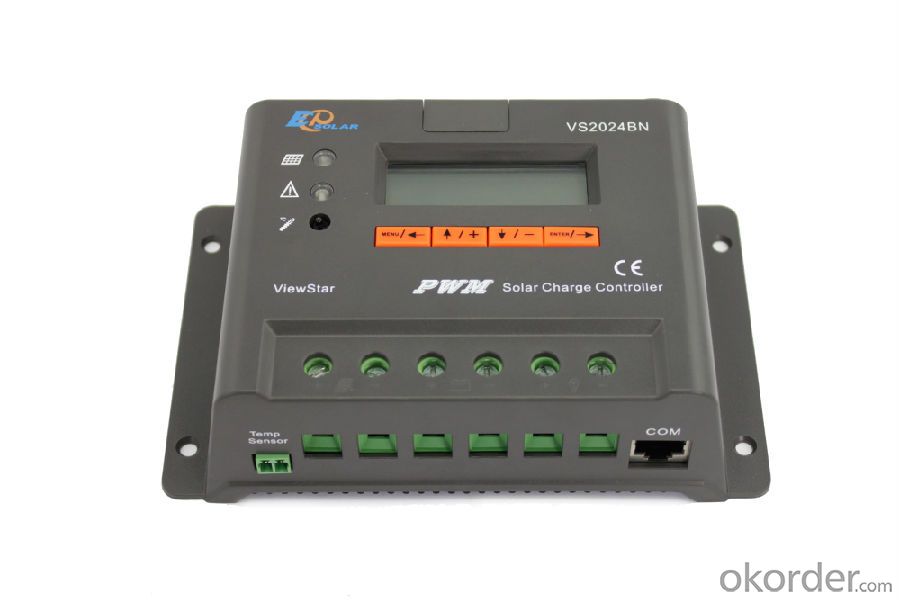
FAQ:
Q1. What is the voltage?
A1. Our 45/60A solar charge controller is 12/24/36/48V auto work.
Q2. What is the difference between MPPT&PWM?
A2. MPPT has higher efficiency, it can track the max power point and won't waste energy.
Q3. What is the efficiency of the MPPT controller?
A3. MPPT>99%, peak conversion efficiency>98%.
Q4. What is the waranty of product?
A4. 12 months.
Q5. What protection does your MPPT controller have?
A5. PV array short circuit, PV reverse polarity, Battery reverse polarity, Over charging, Output short circuit.
- Q:How does a solar controller handle fluctuations in solar panel output?
- A solar controller is designed to handle fluctuations in solar panel output by regulating and optimizing the flow of electricity between the solar panels and the battery bank. When solar panels produce more energy than is needed, the solar controller detects the excess and adjusts the charging current flowing into the batteries accordingly. This prevents overcharging and potential damage to the batteries. On the other hand, when solar panel output decreases due to factors like cloud coverage or shading, the solar controller compensates for this by increasing the charging current to maintain the desired charge level of the batteries. This ensures that the batteries are always being charged efficiently, even during periods of reduced solar panel output. To handle fluctuations in solar panel output, solar controllers also incorporate features such as Maximum Power Point Tracking (MPPT) or Pulse Width Modulation (PWM) technology. MPPT controllers continuously monitor and track the maximum power point of the solar panels, adjusting the voltage and current to maximize the energy harvested from the panels. PWM controllers, on the other hand, regulate the charging current by rapidly switching the solar panel output on and off, maintaining a stable voltage and preventing overcharging. Overall, a solar controller acts as a crucial intermediary between the solar panels and the battery bank, ensuring that the energy generated by the panels is efficiently transferred and stored, regardless of fluctuations in solar panel output.
- Q:What is the maximum current rating of a solar controller?
- The maximum current rating of a solar controller can vary depending on the model and manufacturer. However, common solar controllers typically have maximum current ratings ranging from 10 to 60 amps.
- Q:How do you prevent battery over-temperature with a solar controller?
- One way to prevent battery over-temperature with a solar controller is by incorporating a temperature sensor into the controller. This sensor can monitor the temperature of the battery and send signals to the controller to adjust the charging or discharging rate accordingly. By regulating the flow of energy based on the battery temperature, the solar controller can prevent excessive heat buildup and protect the battery from damage.
- Q:How do I install a solar controller in my solar panel system?
- To install a solar controller in your solar panel system, start by locating the main electrical panel in your home or building. Next, turn off the power supply to ensure safety during the installation process. Mount the solar controller near the solar panels, ensuring it is easily accessible for monitoring and maintenance. Connect the controller's positive and negative terminals to the corresponding terminals on the solar panels. Finally, connect the controller to the battery bank, following the manufacturer's instructions. After completing the installation, you can turn the power supply back on and monitor the controller to ensure it is functioning properly.
- Q:Can a solar controller be used with different types of solar panel cleaning systems?
- Different types of solar panel cleaning systems can be used with a solar controller. The solar controller is responsible for regulating and optimizing the charging and discharging of batteries in a solar power system. Its purpose is to ensure efficient and safe charging of batteries by controlling the flow of electricity from the solar panels. The functioning of the solar controller is not directly affected by the type of solar panel cleaning system used. Its main role is to manage the flow of electricity, and it does not have any specific compatibility requirements with different cleaning systems. However, it is important to consider the compatibility of the solar controller with the overall solar power system and the specific cleaning system being used. The controller should be capable of handling the voltage and current requirements of both the solar panels and the cleaning system. It is advisable to refer to the manufacturer's specifications and guidelines to ensure that the solar controller is suitable for the specific cleaning system being utilized.
- Q:Can a solar controller be used with a solar-powered water pump?
- Yes, a solar controller can be used with a solar-powered water pump. A solar controller helps regulate the power output from the solar panels to the water pump, ensuring optimal performance and preventing overcharging or damage to the pump. It also helps in monitoring and controlling the water pump's operation, improving efficiency and prolonging the lifespan of the system.
- Q:Can a solar controller be used in a community solar system?
- Yes, a solar controller can be used in a community solar system. A solar controller is a crucial component that regulates and optimizes the charging of batteries in a solar system, regardless of its scale. In a community solar system, where multiple households or buildings are connected to a shared solar array, the solar controller ensures the efficient distribution of solar energy and manages the charging and discharging of batteries effectively.
- Q:How does a solar controller handle battery over-temperature disconnect recovery?
- In order to regulate the charging and discharging of batteries in a solar power system, a solar controller is specifically designed. The protection of the batteries from potential damage during battery over-temperature disconnect recovery is a crucial role played by the solar controller. In the event that the battery temperature exceeds the limit, the solar controller detects the excessive heat and triggers a safety mechanism to disconnect the battery from the charging source. This action is taken to prevent further heating and protect the battery from potential damage. After the disconnection of the battery, the solar controller continuously monitors the battery temperature. It waits for the temperature to decrease to a safe level before commencing the recovery process. The recovery process involves reconnecting the battery to the charging source and resuming the charging procedure. Throughout the recovery process, the solar controller closely observes the battery temperature to ensure that it remains within a safe range. If the temperature starts to rise again, the controller will immediately disconnect the battery again to prevent any additional damage. Moreover, advanced solar controllers may have additional safety features, such as temperature sensors or thermal protection circuits. These features provide an extra layer of protection by actively monitoring the battery temperature and taking appropriate actions to prevent over-temperature conditions. In summary, a solar controller effectively manages battery over-temperature disconnect recovery by detecting excessive heat, disconnecting the battery from the charging source, monitoring the temperature, and commencing the recovery process once the temperature reaches a safe level. By doing so, it safeguards the batteries from overheating and potential damage, thereby maximizing their lifespan and performance in a solar power system.
- Q:How do you prevent battery sulfation with a solar controller?
- Battery sulfation can be prevented with a solar controller by implementing a regular maintenance routine. This includes ensuring proper charging and maintenance of the battery, such as keeping it fully charged, avoiding deep discharges, and using a desulfator if necessary. Additionally, using a solar controller with a pulse width modulation (PWM) or maximum power point tracking (MPPT) technology can help optimize the charging process and prevent sulfation.
- Q:How do you troubleshoot common issues with a solar controller?
- To troubleshoot common issues with a solar controller, start by checking the connections and ensuring they are secure. Next, verify that the solar panel is receiving adequate sunlight and that there are no obstructions blocking it. Additionally, inspect the battery to ensure it is properly connected and charged. Check the controller's display for any error codes or abnormal readings that could indicate a problem. If necessary, consult the manufacturer's manual or contact technical support for further assistance.
1. Manufacturer Overview |
|
|---|---|
| Location | |
| Year Established | |
| Annual Output Value | |
| Main Markets | |
| Company Certifications | |
2. Manufacturer Certificates |
|
|---|---|
| a) Certification Name | |
| Range | |
| Reference | |
| Validity Period | |
3. Manufacturer Capability |
|
|---|---|
| a)Trade Capacity | |
| Nearest Port | |
| Export Percentage | |
| No.of Employees in Trade Department | |
| Language Spoken: | |
| b)Factory Information | |
| Factory Size: | |
| No. of Production Lines | |
| Contract Manufacturing | |
| Product Price Range | |
Send your message to us
LCD/LED High Quality PWM Solar anel charge controller/regulator 10a 12/24v with CE ROHS 20A ,12V/24V,VS2024BN
- Loading Port:
- Tianjin
- Payment Terms:
- TT or LC
- Min Order Qty:
- -
- Supply Capability:
- 10000 pc/month
OKorder Service Pledge
OKorder Financial Service
Similar products
New products
Hot products
Hot Searches
Related keywords
